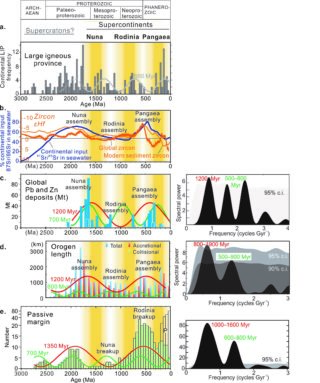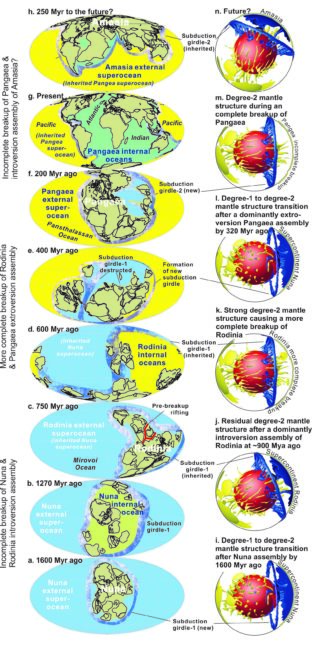Decoding the Earth’s rhythms
Was there a longer superocean cycle on top of the ca. 600 million year supercontinent cycle?
Over 100 years ago, German scientist Alfred Wegener recognised that all the continents on Earth once joined together to form a supercontinent called Pangaea, ca. 300 million years ago (Ma). In the past 30 years, researchers have discovered that Pangaea-like supercontinents existed at least twice before, occurring roughly every 500 to 700 million years (Myr), known as the ca. 600 Myr supercontinent cycle.
If you think 600 Myr is a very long time for anything to repeatedly happen, researchers in recent years identified even longer-term variations in certain geochemical records and in the formation of some mineral deposits (Fig. 1).

Curtin researcher Professor Zheng-Xiang Li and his team, funded by the Australian Research Council’s Laureate Fellowship grant, recently discovered that the answer for this question lies in the history of the deep oceans, which occupy about two-thirds of Earth’s surface. In an article published in the journal of Precambrian Research, the Curtin team reports that supercontinents appear to assemble through two alternating pathways. One is extroversion (e.g., the assembly of Pangaea) where the previous supercontinent (Rodinia) was turned inside-out to form the new supercontinent Pangaea, and in the process the superocean surrounding Rodinia got consumed (see Figures 2c to 2f). The other is called introversion (e.g., the assembly of Rodinia), where the previous superocean, as defined by the circum-Nuna superocean, survived the supercontinent cycle. In this case, the assembly of the new supercontinent (Rodinia) occurred through the collapse of the internal oceans formed during the break-up of the previous supercontinent Nuna (Figures 2a to 2c).
More intriguingly, these two alternating methods of supercontinent assembly determine not only whether the superocean survives, but also whether the circum-superocean ring of fire (e.g., the present-day Pacific ring of fire, which is scientifically referred to as the subduction girdle) survives. If this ring of five survives along with the superocean, then the mantle structure maintains a similar pattern as during the previous supercontinent. If not, then the Earth’s mantle structure gets completely reorganised. The researchers speculate that such alternating pathways of supercontinent assembly (along with the survival or regeneration of the superocean and ring of fire) led to the presence of an Earth cycle which is twice as long as the ca. 600 Myr supercontinent cycle, influencing the formation of some of Earth’s resources.

Contact person: Zheng-Xiang Li, Earth Dynamics Research Group, Curtin University.
Relevant publication:
Zheng-Xiang Li, Ross N. Mitchell, Christopher J. Spencer, Richard Ernst, Sergei A. Pisarevsky, Uwe Kirscher, J. Bredan Murphy, Decoding Earth’s rhythms: Modulation of supercontinent cycles by longer superocean episodes. Precambrian Research, Volume 323, Pages 1-5 (2019).; doi.org/10.1016/j.precamres.2019.01.009.
Read the Curtin University Media Release:
Related articles:
Phys.org; Daily Galaxy; Mirage News; Tech Explorist; Live Science; IFLScience
